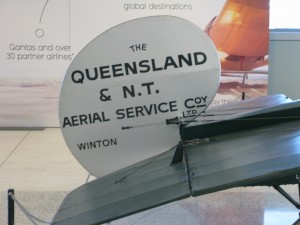 Ever since reading Arthur C. Clarke’s Dolphin Island as a kid I’ve longed to see the Great Barrier Reef.
Ever since reading Arthur C. Clarke’s Dolphin Island as a kid I’ve longed to see the Great Barrier Reef.
Alas, my last couple of visits to this part of the world rendered that impractical: the Reef lies off the coast of Australia’s north Queensland, which as a tropical region is subject to a rainy season – which means cyclones, the region’s variant of hurricanes, in summer and fall. And since both of my previous visits to this country coincided with Sydney’s early-automnal Mardi Gras, heading up to the Reef was out.
This time around, however, it was early enough in the rainy season that I felt more comfortable venturing up north; as it turns out, eastern Australia’s been having a slightly cooler-than-average summer. This translated into very comfortable temps in Sydney – but it’s also meant a relative dearth of rain up north in the wake of last summer’s big floods. So I took the plunge and booked myself on a four-day jaunt to Cairns and environs to see what Far North Queensland had to offer.
I stepped off the plane in the late evening, and the absurdity of my San Francisco-standard light jacket was immediately evident: a soft, humid, tropical breeze was blowing, humid but not too uncomfortably so. For my first night I’d booked myself at accommodations in central Cairns; once again, following my “flashpacker” credo, I’d found a highly-rated, midpriced spot at a local hotel chain.
Next morning, I headed out to explore some sights near Cairns… and it was here that I discovered something the guidebooks – fearful, perhaps, of seeming too negative – only tend to hint at: Cairns may be the base camp for people exploring the region, but it’s an ugly town: a forest of boxy, mid-rise accommodations surrounded by plain-vanilla two-story homes and apartments; a waterfront Esplanade with unspectacular meat-and-potatoes-type eateries on one side, and a boardwalk overlooking the water on the other. “The water” is putting it generously: unlike Sydney’s magazine-brochure beaches, Cairns lies on a tidal mudflat. The Coral Sea here looks nothing like its tropical-dream-sounding name and more like the banks of a dirty lake back home.
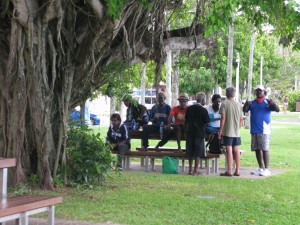 Another observation: Bill Bryson once called Australia’s Aborigines the country’s “invisible minority”; in my week or so in Sydney I don’t think I saw any. Here they appeared, in greater numbers, walking the streets, shopping the malls, or hanging around on the Esplanade. Like some of America’s minorities, they have the feel of an underclass.
Another observation: Bill Bryson once called Australia’s Aborigines the country’s “invisible minority”; in my week or so in Sydney I don’t think I saw any. Here they appeared, in greater numbers, walking the streets, shopping the malls, or hanging around on the Esplanade. Like some of America’s minorities, they have the feel of an underclass.
Heading though the Cairns Central mall – a place as generic as any Stateside – I reached the town’s railway station in the shopping center’s parking garage; there I booked what I’d really come to Cairns to see, something not in the city at all: the town of Kuranda.
As we passed sugarcane fields and turned up into the mountains, the scenery grew more interesting: Kuranda lies in eastern Australia’s Great Dividing Range, though here the mountains lie much closer to the sea than down south. And however lush the hillscape may be near Sydney, it’s more so here, fed by unending tropical rains and warmer temperatures.
Although we tend to associate the word “tropical rainforest” with the Amazon in South America, Australia’s got an abundant share of it, too: in fact, all the world’s rainforests were once connected, part of the primordial southern supercontinent of Gondwanaland.
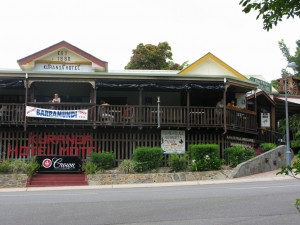 I stepped off the shuttle bus into Kuranda’s center; yep, it’s a tourist town. Lots of shops and markets. But these seemed a mite more interesting than the usual ticky-tack: the place was once (so sayeth the official guides) “a center for alternative lifestyles,” (we can only infer what that means), and retains a stable of artists and craftspeople. It proved a suitable place to shop for some small gifts for the nieces and nephews back home.
I stepped off the shuttle bus into Kuranda’s center; yep, it’s a tourist town. Lots of shops and markets. But these seemed a mite more interesting than the usual ticky-tack: the place was once (so sayeth the official guides) “a center for alternative lifestyles,” (we can only infer what that means), and retains a stable of artists and craftspeople. It proved a suitable place to shop for some small gifts for the nieces and nephews back home.
After a quick bit of surprisingly decent pizza at an actual rainforest café (no theme-parkery needed in these parts), I ambled over to the train station. Two trains sat parked on the station platforms, each a long line of wooden carriages from the late-19th century capped by colorfully-painted diesel locomotives. Inside, the carriages retained their period feel, dark woods, patterned white ceilings and open windows. The train wasn’t too crowded, though the mix of mostly families led me to wonder if this wasn’t another lame attraction.
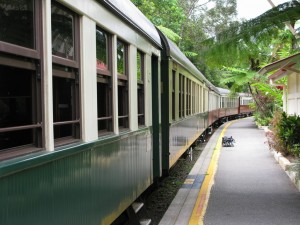 As we got moving, a surprisingly insightful audio narration (with accompanying still video on modern-day LCD screens) told the story of the line and the scenery around it: like so many pretty spots now given over to tourism, the Cairns area got its start in resource extraction – gold in particular. The rail line was built to get at the gold fields in the mountains. As with the construction of similar such transport infrastructure in the Americas, realizing this with century-plus ago technology was an immense, hazardous undertaking. I’m struck by how often we forget, in our comfortable, often banal technology-age existence, the hardships endured by so many in the not-so-long-ago past to build the comforts we now take for granted.
As we got moving, a surprisingly insightful audio narration (with accompanying still video on modern-day LCD screens) told the story of the line and the scenery around it: like so many pretty spots now given over to tourism, the Cairns area got its start in resource extraction – gold in particular. The rail line was built to get at the gold fields in the mountains. As with the construction of similar such transport infrastructure in the Americas, realizing this with century-plus ago technology was an immense, hazardous undertaking. I’m struck by how often we forget, in our comfortable, often banal technology-age existence, the hardships endured by so many in the not-so-long-ago past to build the comforts we now take for granted.
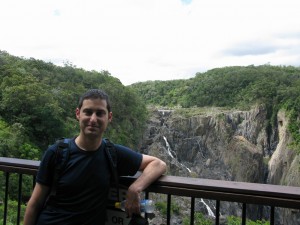 As the train rounded a corner and came to Barron Gorge, any “is this worth it?” uncertainties I may have felt instantly evaporated: nearly a thousand feet deep, the gorge is a wonder, a verdant Grand Canyon of Tropical North Queensland. The waterfall that plunges down the rocky chasm was just a trickle on this day, a combination of the dam built in this spot and the modest amount of rain the region’s had this season so far.
As the train rounded a corner and came to Barron Gorge, any “is this worth it?” uncertainties I may have felt instantly evaporated: nearly a thousand feet deep, the gorge is a wonder, a verdant Grand Canyon of Tropical North Queensland. The waterfall that plunges down the rocky chasm was just a trickle on this day, a combination of the dam built in this spot and the modest amount of rain the region’s had this season so far.
The narrow-gauge train continued winding its way downhill, twisting across viaducts spanning deep chasms, chugging in and out of tunnels (aligning all these tunnels with pre-contemporary engineering equipment was a miraculous undertaking), finally reaching the flat plains toward Cairns. Dozens died building this line; it’s rumored the bodies of some are buried inside the track’s foundations. Still others are buried at McLeod Cemetery in Cairns proper, spending eternity with a view of the line they gave their lives to create. The engineering geek in me, coupled with the vista-loving romantic, made this journey reason enough to spend that single night in Cairns itself.
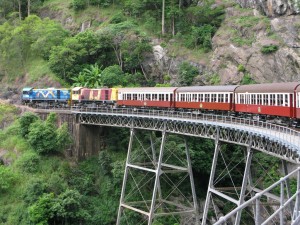 With that complete, however, it was time to head up to my more permanent home base in these parts: the town of Port Douglas, some forty miles northward up the coast.
With that complete, however, it was time to head up to my more permanent home base in these parts: the town of Port Douglas, some forty miles northward up the coast.
The drive to Port Douglas seemed to suggest my blend of stays was right: Cook Highway was a glory, the blue Coral Sea on one side and rainforested hillsides on the other. As it headed toward dusk, the shuttle bus dropped me off at my accommodations for the next three days: the LGBT-owned Pink Flamingo Resort. A former 1970s-era motel converted into a colorful gay & lesbian villa-style inn, the place looked promising on the one hand: lush gardens, a pretty pool, colorfully painted and decorated. The former carports were redesigned into private villa forecourts, complete with most wonderful outdoor shower and soaker tub. They even invited guests to choose their own wooden placard indicating “do not disturb;” I immediately found one to my liking and hung it on my entryway (see picture).
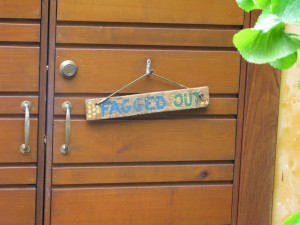 On the other hand, the inn also reminded me to think twice about booking myself, the inveterate solo traveler, into places touted as “romantic hideaways.” It was sleepy and deserted in the early evening, though later in the night a gaggle of friendly ladies congregated around the pool and bar area. An aloof gay couple – one a fellow probably my age, another a bunch of years younger (boy, does that sound familiar) – hung around the pool over the days I was there, saying not a word to anyone. As a former motor inn, the Pink Flamingo lay a bit of a walk from Port Douglas’ main drag, Macrossan Street; the next morning, rising early for one of my planned excursions, I walked and walked in some light rain showers past a smattering of closed eateries and other establishments. Was this a mistake? I wondered as I organized my stuff for the number-one reason I came out here: an excursion to the Great Barrier Reef.
On the other hand, the inn also reminded me to think twice about booking myself, the inveterate solo traveler, into places touted as “romantic hideaways.” It was sleepy and deserted in the early evening, though later in the night a gaggle of friendly ladies congregated around the pool and bar area. An aloof gay couple – one a fellow probably my age, another a bunch of years younger (boy, does that sound familiar) – hung around the pool over the days I was there, saying not a word to anyone. As a former motor inn, the Pink Flamingo lay a bit of a walk from Port Douglas’ main drag, Macrossan Street; the next morning, rising early for one of my planned excursions, I walked and walked in some light rain showers past a smattering of closed eateries and other establishments. Was this a mistake? I wondered as I organized my stuff for the number-one reason I came out here: an excursion to the Great Barrier Reef.
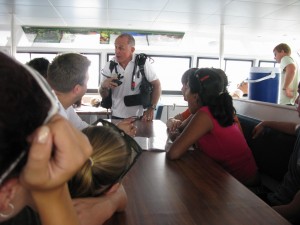 As a group of us boarded the catamaran under the auspices of Calypso Reef Cruises at the nearby Port Douglas marina, my apprehension faded: a broad assortment of families, couples, and a few other solo travelers listened as our dive guide Charlie – an affable mélange of Bob Hoskins and Jacques Cousteau – briefed us on the basics of scuba diving. Although I’d been a bit of a water baby when I was younger, my years in chilly-water California have meant I’ve never done any diving before. As I was fitted with flippers, a mask, and an Aqualung and hopped off the back of the catamaran some thirty miles from shore, I wasn’t quite sure what to expect.
As a group of us boarded the catamaran under the auspices of Calypso Reef Cruises at the nearby Port Douglas marina, my apprehension faded: a broad assortment of families, couples, and a few other solo travelers listened as our dive guide Charlie – an affable mélange of Bob Hoskins and Jacques Cousteau – briefed us on the basics of scuba diving. Although I’d been a bit of a water baby when I was younger, my years in chilly-water California have meant I’ve never done any diving before. As I was fitted with flippers, a mask, and an Aqualung and hopped off the back of the catamaran some thirty miles from shore, I wasn’t quite sure what to expect.
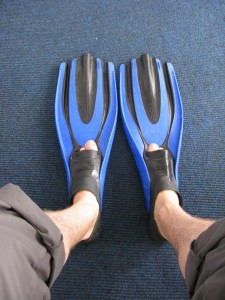 Well, the experience, like so many others, borders on the indescribable… but I now utterly understand the notion that we’ve explored outer space more than we’ve explored our inner space under the sea: the absence of buoyancy and the ever-changing air/water pressure give diving an otherworldly feel unlike any I’ve had to date, and the blue water feels mysterious and enchanted from the moment of total immersion.
Well, the experience, like so many others, borders on the indescribable… but I now utterly understand the notion that we’ve explored outer space more than we’ve explored our inner space under the sea: the absence of buoyancy and the ever-changing air/water pressure give diving an otherworldly feel unlike any I’ve had to date, and the blue water feels mysterious and enchanted from the moment of total immersion.
The reef itself, meanwhile, really does need to be experienced up close and personal (photos coming soon!): although we’d been warned in an interpretive briefing (by the diving company’s one truly fetching fellow, a blonde New Zealander) that the colors we’d be seeing aren’t quite as bright as in all those movies and photos (where they’re aided by flash photography and the wonders of CGI)… well, no complaints from me. On the dive down to sixteen meters (some forty-five feet) we spotted Christmas tree worms, brightly-colored fan-shaped protrusions from the coral that pop in when you come close to them; fat sea cucumbers lazing on the bottom (these can even be picked up without bother to them); giant sea clams, their colorful eye spots prompting the creature to, well, clam up at the first sign of danger; brilliantly-hued fish of all persuasions – yes, including clownfish hiding in anemones, made famous by the Pixar film Finding Nemo; a reef shark, hanging out on the bottom before his nighttime feed; and all manner and type of coral. These colonies of polypy creatures manufacture the eponymous material in vast colonies; the Barrier Reef, consisting of many reefs, in fact, is the largest single thing built by living organisms – and unlike those inflated claims about the Great Wall of China, the Reef can in fact be seen from outer space.
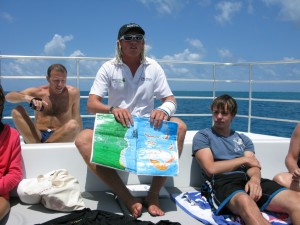 For the second and third dives of the day, I opted for a snorkeling experience, which in these parts is almost a better way to go: coral lives in a symbiotic relationship with algae, and so seeks the sunlight. However, it also can’t live out of the water, so the low-tide mark is typically as high as it can grow. This translates into immense shallow regions – three feet deep is not uncommon – making a foray with a snorkel eminently practical. With the rain having long cleared and the few clouds that remained sticking close to land, the reef was brilliantly illuminated with dapples of sun. Fish swam all around, oblivious to we curious humans; one of them, an especially social little critter, kept on coming within a foot of my mask. For those who know me, I’m no spiritualist, but my day out here on the Reef reaffirmed that this is indeed a hallowed place that needs to be protected and nurtured.
For the second and third dives of the day, I opted for a snorkeling experience, which in these parts is almost a better way to go: coral lives in a symbiotic relationship with algae, and so seeks the sunlight. However, it also can’t live out of the water, so the low-tide mark is typically as high as it can grow. This translates into immense shallow regions – three feet deep is not uncommon – making a foray with a snorkel eminently practical. With the rain having long cleared and the few clouds that remained sticking close to land, the reef was brilliantly illuminated with dapples of sun. Fish swam all around, oblivious to we curious humans; one of them, an especially social little critter, kept on coming within a foot of my mask. For those who know me, I’m no spiritualist, but my day out here on the Reef reaffirmed that this is indeed a hallowed place that needs to be protected and nurtured.
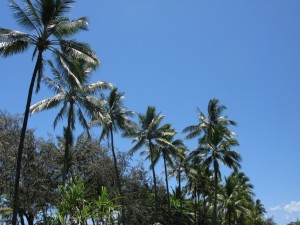 A speedy boat ride back to town, then time for a bite of dinner… and here’s where I ran into Port Douglas’ ongoing challenge for the single flashpacker fellow: the town’s become something of a foodie destination, but with the Aussie dollar sky-high I chose to limit myself to not-so-pricey eateries. Still, to celebrate my day on the reef I felt like treating myself a tad, and asked for a “table for one” at one of the town’s more popular and better-ranked restaurants.
A speedy boat ride back to town, then time for a bite of dinner… and here’s where I ran into Port Douglas’ ongoing challenge for the single flashpacker fellow: the town’s become something of a foodie destination, but with the Aussie dollar sky-high I chose to limit myself to not-so-pricey eateries. Still, to celebrate my day on the reef I felt like treating myself a tad, and asked for a “table for one” at one of the town’s more popular and better-ranked restaurants.
“Do you have a reservation?” said the hostess, eyeing my bicycle helmet and my solitary status. I said I didn’t and it didn’t look like I needed one – the place was half-empty.
“Sorry, we’re full up this evening,” she said. Really? Crestfallen, I picked an okay, not-as-fab nearby spot. When I cruised by my hoped-for place some time later, it was still at half-capacity. Interestingly, the aloof gay couple from my resort was eating there.
Huh? Interestingly, I’d brought with me a copy of last month’s Atlantic magazine that covered the rising trend of singledom in America and across the developed world. One writer, interviewed for the piece, has even recently coined a term to describe our society’s ongoing stigma of the uncoupled: singlism. I can’t say whether this experience on this night in Port Douglas was an example of that or not, but I can only hope that in future years we learn to look upon the unpartnered as something more than crazy cat ladies or cranky, uncompromising bachelors.
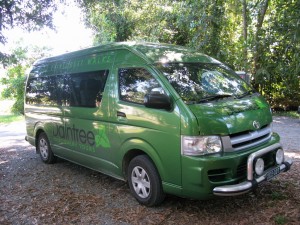 The next day I’d signed up for a more terrestrial adventure, an afternoon rainforest tour. Gary, a middle-aged fellow with mottled bald head, picked me and a number of other area visitors (including a couple from India who were on my dive the day before) and drove us north, toward the World Heritage-listed Daintree Rainforest.
The next day I’d signed up for a more terrestrial adventure, an afternoon rainforest tour. Gary, a middle-aged fellow with mottled bald head, picked me and a number of other area visitors (including a couple from India who were on my dive the day before) and drove us north, toward the World Heritage-listed Daintree Rainforest.
“Port Douglas had more than 40,000 people at its height after they found gold,” Gary said as we drove north past more fields of sugarcane. It was only with the building of the Kuranda railway down south that Cairns became the more prominent of the two towns. Perhaps that was a blessing in disguise: sleeping its way through much of the twentieth century until Aussie impresario Christopher Skase built the sprawling Mirage resort in the 1980s, Port Douglas now keeps its population and development in check.
“We don’t want another [Australian] Gold Coast or Miami Beach,” Gary offered. Shit, you don’t even have to look that far, I thought. Have you been to Cairns lately?
We soon stopped at the Daintree River, a brackish tidal inlet, for a mellow boat ride seeking saltwater crocodiles, tree frogs, and other elements of the river’s bestiary.
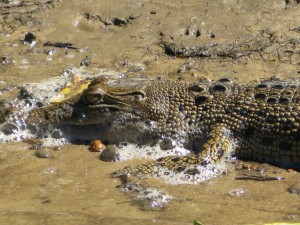 Crocodiles form harems, as the males are often killed off by fighting and it’s evolutionary preferable for them to have a high female-to-male ratio to keep the species going. Only a small fraction make it into adulthood (their lifespans are similar to those of humans) – but if they do, they grow huge: twenty-footers are not uncommon.
Crocodiles form harems, as the males are often killed off by fighting and it’s evolutionary preferable for them to have a high female-to-male ratio to keep the species going. Only a small fraction make it into adulthood (their lifespans are similar to those of humans) – but if they do, they grow huge: twenty-footers are not uncommon.
Nothing that big was out on the muddy river that afternoon, but we did spot some smaller fellows (by age six they’re already some five-plus feet long, and we did see some of those); our eagle-eyed guide also directed us to iridescent-green tree frogs and slumbering snakes. A comedian once remarked that nature is the world’s biggest restaurant, what with one species eating another… but it continues to amaze me how the vast global ecosystem manages to remain in balance.
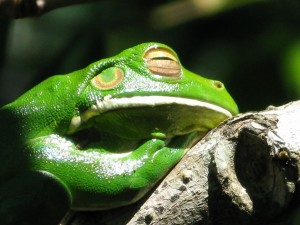 Since none of us fancied being a croc’s supper, we next stopped at Mossman Gorge, up in the rainforested mountains, for a short hike and swim among the great timeworn boulders. With water too cool, too fresh, and too swift for crocs, we ventured without fear into the sparkling pure stream under the watchful canopy of greenery. Yes, water princess here took her time getting acclimated to the cooler waters (probably one of the only spots in Tropical North Queensland where water temps were as chilly as the ocean up north near Sydney), but it was eminently worthwhile. That evening, on my return, I even gave the outdoor shower at my Pink Flamingo villa a whirl and found it equally revitalizing.
Since none of us fancied being a croc’s supper, we next stopped at Mossman Gorge, up in the rainforested mountains, for a short hike and swim among the great timeworn boulders. With water too cool, too fresh, and too swift for crocs, we ventured without fear into the sparkling pure stream under the watchful canopy of greenery. Yes, water princess here took her time getting acclimated to the cooler waters (probably one of the only spots in Tropical North Queensland where water temps were as chilly as the ocean up north near Sydney), but it was eminently worthwhile. That evening, on my return, I even gave the outdoor shower at my Pink Flamingo villa a whirl and found it equally revitalizing.
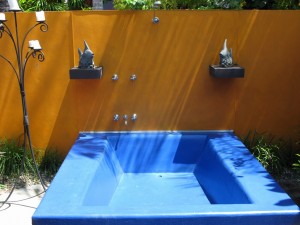 For my last morning in Port Douglas, I ambled about town: I’d rented a bike from my accommodations, which proved stellar for getting around the mostly-flat town. But the place has one hill, at the very tip of the peninsula abutting the center of town. Here I chose to hoof it, and was soon enveloped by the forested canopy of Flagstaff Hill. As the town grew trendy through the 1990s and beyond, many celebrities chose to holiday here; the elegant modern homes dotting the Hill – scant yards from the town’s commercial strip of Macrossan Street – bear witness to this place’s glitterati status.
For my last morning in Port Douglas, I ambled about town: I’d rented a bike from my accommodations, which proved stellar for getting around the mostly-flat town. But the place has one hill, at the very tip of the peninsula abutting the center of town. Here I chose to hoof it, and was soon enveloped by the forested canopy of Flagstaff Hill. As the town grew trendy through the 1990s and beyond, many celebrities chose to holiday here; the elegant modern homes dotting the Hill – scant yards from the town’s commercial strip of Macrossan Street – bear witness to this place’s glitterati status.
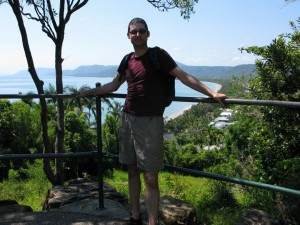 The top of the Hill rewarded me with a lookout, where I could survey all the spots I’d visited over the past days: the Daintree to the north, the Reef to the east, the beachfront café where I’d had a stellar pancake breakfast earlier that morning. The town’s Four Mile Beach stretched southward; interestingly, it was mostly bereft of swimmers, as are all beaches in North Queensland this time of year: the “wet” is stinger season, when the deadly box jellyfish and not-as-deadly but tougher to fend off Irukandji jellyfish hover around the beaches; swimming in the ocean waters up here is thus a necessarily confined affair, done in little enclosures surrounded by “stinger nets.” I didn’t bother, having gone out on the Reef just the other day (where the risk of jellyfish is far smaller than near land).
The top of the Hill rewarded me with a lookout, where I could survey all the spots I’d visited over the past days: the Daintree to the north, the Reef to the east, the beachfront café where I’d had a stellar pancake breakfast earlier that morning. The town’s Four Mile Beach stretched southward; interestingly, it was mostly bereft of swimmers, as are all beaches in North Queensland this time of year: the “wet” is stinger season, when the deadly box jellyfish and not-as-deadly but tougher to fend off Irukandji jellyfish hover around the beaches; swimming in the ocean waters up here is thus a necessarily confined affair, done in little enclosures surrounded by “stinger nets.” I didn’t bother, having gone out on the Reef just the other day (where the risk of jellyfish is far smaller than near land).
And with that, an adieu to this most wondrous of places; another scenic drive down Cook Highway for my flight back to Sydney, where I had still one day left before my long, long voyage home.
Tags: No Comments





0 responses so far ↓
Like gas stations in rural Texas after 10 pm, comments are closed.